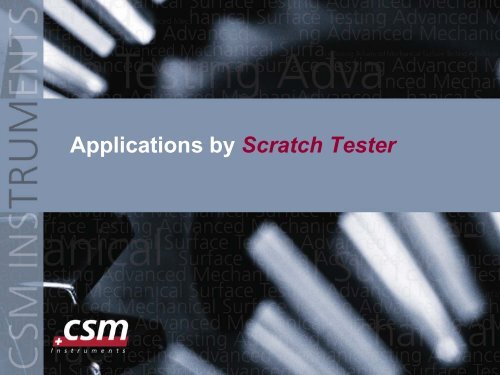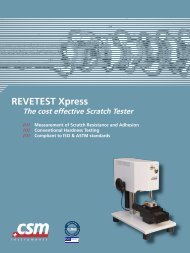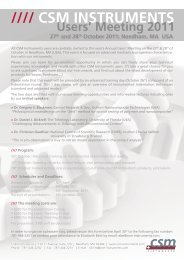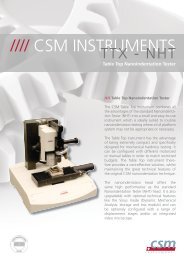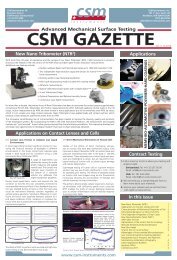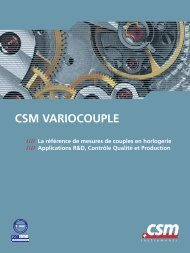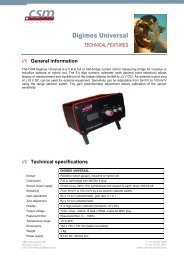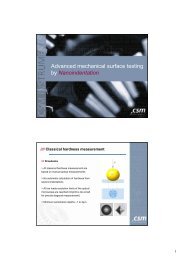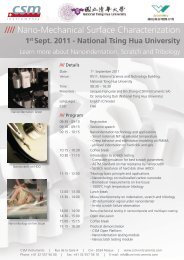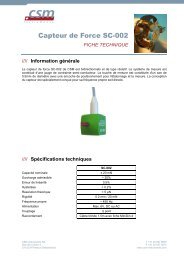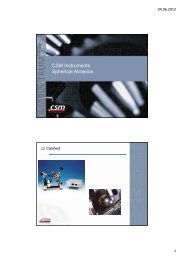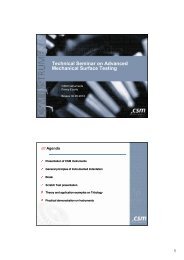Hard ceramic coatings (1-5um thick) - CSM Instruments
Hard ceramic coatings (1-5um thick) - CSM Instruments
Hard ceramic coatings (1-5um thick) - CSM Instruments
Create successful ePaper yourself
Turn your PDF publications into a flip-book with our unique Google optimized e-Paper software.
Applications by Scratch Tester
<strong>CSM</strong> Scratch Testers<br />
Nano Micro Macro (Revetest)<br />
Approx. Load range* up to 1 N up to 30 N up to 200N<br />
Max depth 2 mm 1 mm 1 mm<br />
* depending on room noise floor, acoustic,…
Examples Scratch Test<br />
Load Range: 1-200N<br />
Indenter type: Rockwell Diamond, radius 50-800um<br />
Typical materials: <strong>Hard</strong> <strong>ceramic</strong> <strong>coatings</strong> (1-<strong>5um</strong> <strong>thick</strong>)<br />
DLC, TiN, TiCN, TiAlN, CrN, ZrO2, TiO2, Al2O3<br />
Main application fields:<br />
Cutting tools<br />
Engines parts<br />
Decorative <strong>coatings</strong><br />
Other applications:<br />
Biomedical (Hip or knee prostheses)<br />
Protective polymer <strong>coatings</strong> on Steel (100-800um)<br />
Bulk <strong>ceramic</strong>s<br />
Turbine blades
Automotive application<br />
RST test on a rocker arm<br />
Double layer coating, TiN 1 �m / DLC 2 �m
Coatings for prostheses<br />
Different hard <strong>coatings</strong> such as TiN have already been<br />
used for some time for wear resistance in prosthetic<br />
implants. Quality control of such materials can be<br />
performed with the Micro Scratch Tester, even on curved<br />
surfaces such as the ball of a ball-and-socket joint. The<br />
instrument force feedback ensures that the applied load<br />
remains as-programmed for the duration of the test.<br />
Frictional data is also of importance and can be related to<br />
the in-vivo application.<br />
1 2<br />
3<br />
4
Examples Scratch Test
Polymer coating on contact lens<br />
Progressive load range: 0 - 4 mN<br />
Indenter radius: 2 µm<br />
Contact lens kept flat by capillary forces<br />
Lc1 = 1.56 mN (first cracking)<br />
Lc2 = 3.85 mN (rupture)
Polymer varnish on ABS-PC mobile phone<br />
First failure = 25 mN<br />
Rupture = 33 mN
Scratch and mar resistance of paint <strong>coatings</strong> and<br />
polymer films using the nanoscratch technique:<br />
Viscoelastic behavior and relaxation effects<br />
Industrial Problem:<br />
Automotive topcoats, or varnishes, are exposed to extremely harsh<br />
environmental conditions, yet they are expected to maintain a high<br />
gloss finish for at least 5 years<br />
Solution:<br />
Develop a consistent and reproducible test method which can<br />
measure fracture type scratch resistance of automotive topcoats and<br />
correlate to customer quality indicators
System description<br />
Mar resistance characterises the ability of a coating to resist damage<br />
caused by light abrasion<br />
The difference between mar and scratch resistance is that mar is related<br />
only to the very fine surface scratches which spoil the appearance of the<br />
coating<br />
Mar resistance depends on a complex interplay between viscoelastic or<br />
thermal recovery, yield or plastic flow, and fracture.<br />
The mechanical properties of polymeric clearcoats are rate and temperature<br />
dependent and viscoelastic recovery can cause scratches to change with<br />
time<br />
Metallic Substrate<br />
Clearcoat ( ~ 45 - 50 µm)<br />
Pigmented Basecoat ( ~ 12 µm)<br />
Primer ( ~ 50 µm)
Polymer coating<br />
20µm<br />
Progressive normal load scratch (0 - 20 mN)<br />
Diamond tip radius = 2 �m<br />
20µm<br />
Sample A<br />
Sample B<br />
20µm<br />
Normal Force (mN)<br />
20<br />
16<br />
12<br />
8<br />
4<br />
0<br />
Pd - A<br />
Rd - A<br />
Rd - B<br />
Pd - B<br />
0 0.2 0.4 0.6 0.8 1 1.2 1.4 1.6 1.8 2<br />
scratch length (mm)<br />
0<br />
1.5<br />
3<br />
4.5<br />
6<br />
7.5<br />
Depth (µm)<br />
Sample A<br />
Sample B<br />
20µm
Permanent deformation at 5mN (µm)<br />
//// Polymer analysis<br />
0.5<br />
0.45<br />
0.4<br />
0.35<br />
0.3<br />
0.25<br />
0.2<br />
0.15<br />
0.1<br />
0.05<br />
0<br />
Better<br />
sample B<br />
Better<br />
sample A<br />
0 10 20 30 40 50<br />
Normal force at fracture (mN)<br />
sample C


